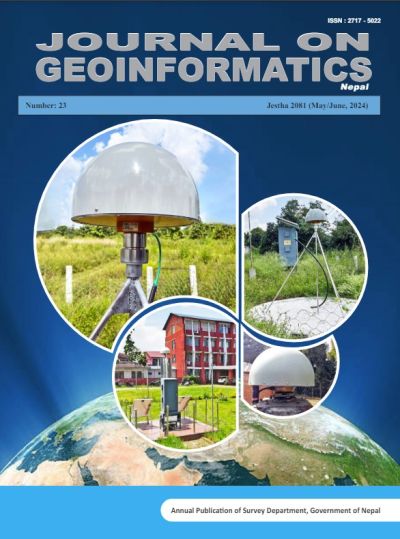Modified One-Point-and-Area Algorithm for Sub-division of Irregular Parcels
DOI:
https://doi.org/10.3126/njg.v23i1.66266Keywords:
Polygon Sub-division, Irregular-shaped parcel, One-point-and-area, Land parcels, Cadastre, Concave parcelAbstract
Parcel sub-division is a crucial part of the Land Administration, and its techniques depend on the user requirements and other constraints. Splitting of a parcel based on a given area is one of such constraints whose subdivision has been popularly carried out using the trial-and-error method which is less accurate and time-consuming. For more accurate and direct subdivision, Habib developed algorithms based on popular eight cases. Among them, when the area to be split is known, a point or line is selected as a reference. In case if it has to be a point, then a one-point-and-area method is used for subdivision while a move-line-and-area method is used if line segment is used as reference. It was found that Habib Algorithm worked well for convex shapes, however it could not account for the concavity of irregular-shaped parcels. It was found that the approach for the calculation of the area considered only the cases of convex shapes. Therefore, the researchers observed the issues of clinging and retracting were identified. Thus, this study proposes an effective algorithm for the division of an irregular parcel using an improved version of One-Point-and-Area method used in Habib Algorithm. An additional stage of generating a convex hull was introduced to guide the iteration process, the formula to calculate area was adjusted to compute only the interior area and finally, the determination of the partition polygon was also done through an iterative improvement process rather than the existing one-step process. Experiments showed that the proposed algorithm accurately divided both irregular-shaped parcels and convex parcels. In the case of convex parcels, the result was found to be the same as Habib’s method. Due to the addition of an extra stage of generating a convex hull and extra iterations in the final stage, the proposed algorithm consumed more time. However, it was found negligible in regard to the volume of parcels involved in splitting at a time. Overall, the proposed algorithm accurately solved the issues of clinging and retracting irregular polygons and without changing the results in convex polygons. So, it was concluded to be a suitable replacement of Habib Algorithm, and its implementation will provide more accurate results in parcel sub-division problems.




